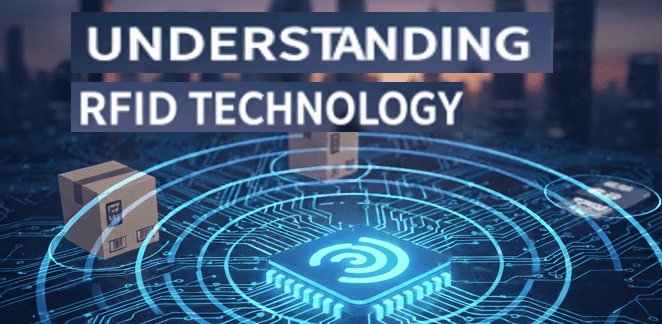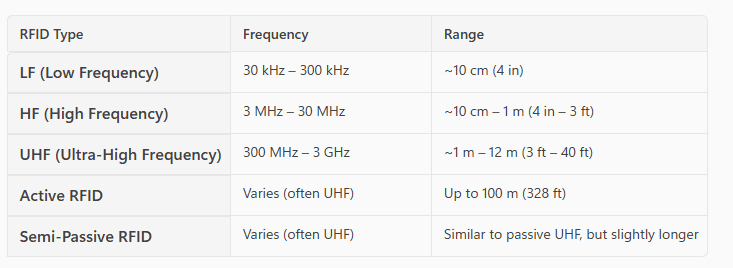RFID How it works / Use Cases

Note: Written with the help of my research and editorial team 🙂 including: (Google Gemini, Google Notebook LM, Microsoft Copilot, Perplexity.ai, Claude.ai and others as needed)
Definition
RFID stands for Radio Frequency Identification a technology used to automatically identify and track objects using radio waves.
An RFID system typically consists of two main components:
- RFID Tag: This is a small device that contains a microchip and an antenna. It stores data about the item it’s attached to.
- Passive tags: Don’t have a power source; they draw energy from the reader’s signal.
- Active tags: Have their own battery and can transmit signals over longer distances.
- RFID Reader: This device emits radio waves and receives signals back from RFID tags. It reads the data stored on the tag and sends it to a computer system for processing.
Advantages
- Fast scanning (up to 700 items/sec).
- No line-of-sight required.
- Enables automation and efficiency.
Disadvantages
- Security Risks: Data can be skimmed; potential for fraud.
- Technical Issues: Signal interference, lack of global standards.
- Cost & Setup: Hardware and labor-intensive implementation.
Common Use Cases:
- Inventory Management: Tracking goods in warehouses and retail stores.
- Retail & Supply Chain: Inventory management, theft prevention.
- Customer Engagement: NFC tags for promotions and payments (e.g., ApplePay).
- Asset Tracking: Vehicles, high-value equipment.
- Personal Use: Pet tracking, medical monitoring.
- Access Control: Key cards for buildings or secure areas.
- Supply Chain Logistics: Monitoring shipments and reducing loss.
- Libraries: Managing book checkouts and returns.
- Healthcare: Tracking equipment, medications, and patient information.
- Animal Tracking: Microchips in pets or livestock.
RFID Types:
- Passive RFID Tags: No battery, short range, powered by reader’s signal. They are economical and widely used in supply chains. Types include:
- LF (Low Frequency): 30 kHz–300 kHz; short range, less interference.
- HF (High Frequency): 3–30 MHz; good memory, used in libraries and NFC.
- UHF (Ultra-High Frequency): 300 MHz–3 GHz; long range, common in supply chains.
- Active RFID Tags: Battery-powered; longer range (up to 100 meters), used for real-time tracking. Durable but can be costly.
- Semi-Passive: Battery assists activation but doesn’t transmit continuously.

How Passive RFID Tags Work
- Tags have no battery; they rely on the reader’s electromagnetic field for power.
- A reader must be within range (usually a few centimeters to a few meters depending on frequency) to energize and read the tag.
- Without a reader actively scanning, tags remain silent.
How Active RFID Tags Work
Active tags have their own power source, allowing them to broadcast signals over longer distances. They are ideal for real-time tracking and monitoring in large areas.
Real-World Examples
- Retail: Tesco and Uniqlo
- Tesco, one of the UK’s largest supermarket chains, adopted RFID technology in 2003 to track inventory. This system improved inventory accuracy from 65%-75% to 93%-99%, reduced shrinkage, and optimized the supply chain, saving millions of pounds annually. Similarly, Uniqlo has implemented RFID-enabled self-checkout systems in stores worldwide, allowing customers to scan entire baskets of items simultaneously, speeding up the checkout process and reducing labor costs.
- Agriculture: Livestock and Crop Tracking
- RFID chips attached to animals help farmers monitor health records, track breeding cycles, and manage movement efficiently. RFID-enabled soil and weather sensors collect real-time data on moisture levels, temperature, and nutrient conditions, driving the new era of precision agriculture.
- Aviation: Luggage and Cargo Management
- Airlines use RFID baggage tags to track luggage throughout the journey, enhancing cargo visibility and automating baggage and cargo sorting. This reduces the risk of lost luggage and improves logistics management.
- Healthcare: Patient and Asset Tracking
- Medical centers use RFID technology to identify and track at-risk patients, manage equipment, and monitor medications. This promotes safety and efficiency in healthcare settings.
- Public Transport and Payments
- RFID technology is used in public transport for entrance payment and exit control, as well as in electronic toll collection systems. Cars equipped with RFID tags can pass through tolls without stopping, making travel more convenient and efficient.
- Pet Tracking
- RFID is widely used in pet tracking. In the UK, it is now law for all dogs and cats to be microchipped, ensuring pets can be identified and returned if lost.
A Specific Use Case
A question that I recently received is whether it’s possible to walk into a room and automatically see a list of all devices tagged with RFID. The answer is that passive RFID alone cannot achieve this. To automatically broadcast what’s in a room, you would need:
- Active RFID tags that continuously transmit their presence.
- RFID readers installed in the room that continuously scan and report tag data.
Without these, passive tags remain silent until a reader actively scans them.
RFID technology is a powerful tool that continues to transform industries and everyday life, offering unprecedented levels of automation, efficiency, and convenience, however, while active RFID tags are often required for real-time, automatic detection of assets within a room, I think I would recommend a different approach for use case. Absolute Software offers a compelling alternative for organizations seeking comprehensive asset tracking without the need for active tags. Absolute leverages persistent firmware-level connections to endpoints, enabling continuous monitoring of device location, status, and usage—regardless of whether the device is on or off the network. This means that even without active RFID infrastructure, businesses can track hardware across locations, receive alerts for unauthorized movement, and maintain detailed audit trails. With features like geofencing, remote device freezing, and automated reporting, Absolute provides a secure, scalable solution for asset visibility and control, making it ideal for environments where deploying active RFID tags may be impractical or cost-prohibitive.
Are Apple AirTags RFID Devices?
Apple AirTags are not RFID devices. They use a different technology that rely primarily on Bluetooth and Ultra-Wideband (UWB) technology.
Here’s how they work:
- Bluetooth: AirTags send out a secure Bluetooth signal that can be detected by nearby Apple devices (like iPhones, iPads, or Macs) in the Find My network. These devices then relay the AirTag’s location to iCloud, allowing the owner to see its position in the Find My app.
- Ultra-Wideband (UWB): On compatible Apple devices (iPhone 11 and later), AirTags use UWB for precise, directional location tracking, helping users find their items with greater accuracy.
- NFC: AirTags also have a built-in NFC chip, which allows anyone with an NFC-capable smartphone to tap the AirTag and access contact information if it’s in Lost Mode.
While AirTags do use NFC (which is a type of RFID), their main tracking functionality is based on Bluetooth and UWB, not traditional RFID. This means AirTags are not affected by RFID blockers and operate differently from standard RFID tags used in inventory management or access control.

